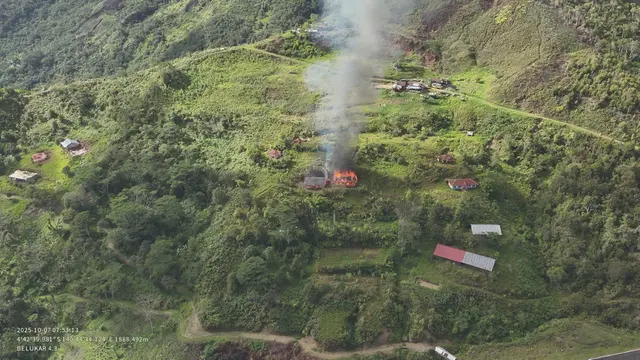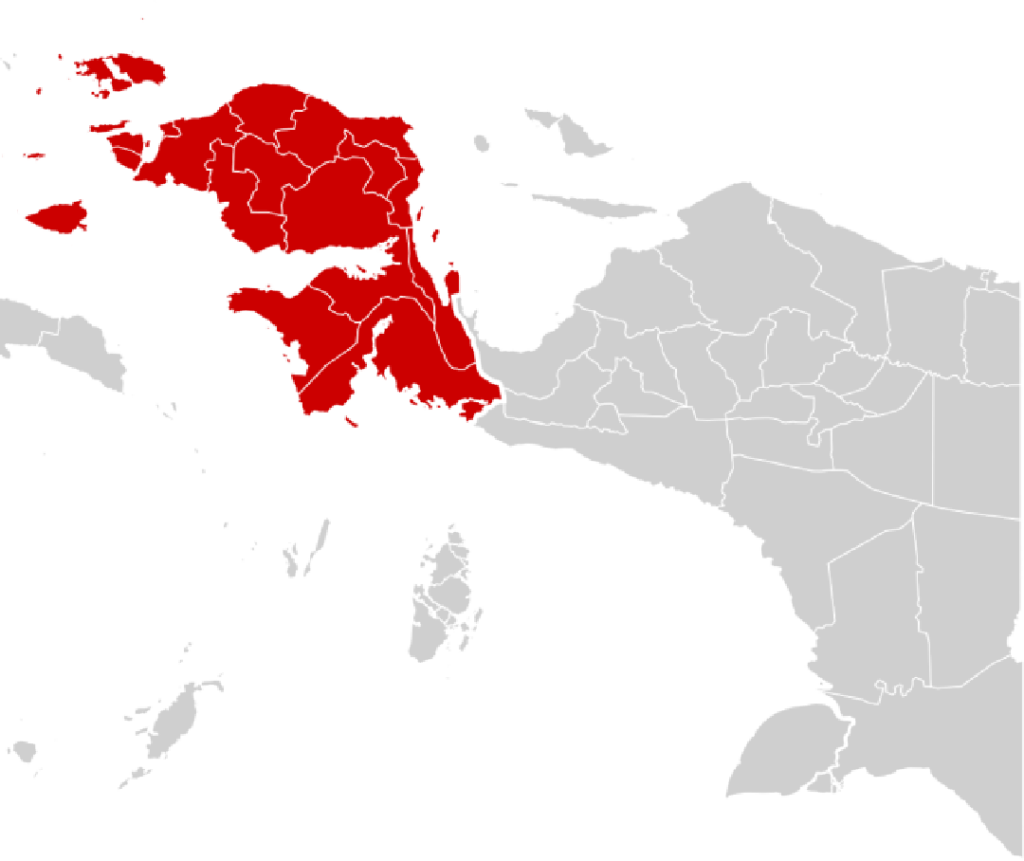In the lush, isolated highlands of Sopamikma Village, Kiwirok District, nestled deep within Pegunungan Bintang Regency, Papua Pegunungan (Papua Highland) Province, a school once stood as a beacon of learning and hope. SMP Negeri Kiwirok wasn’t just a building—it was a symbol of possibility for the children of this remote Papuan region. But on the morning of October 7, 2025, flames devoured that symbol. The fire was not an accident. It was intentional, orchestrated, and deeply symbolic.
Sixteen armed men—allegedly from the KKB (Armed Criminal Group) Ngalum Kupel, a faction of the TPNPB-OPM (West Papua National Liberation Army – Free Papua Movement)—descended upon the village of Sopamikma, pouring fuel onto the school’s walls before setting it alight. The attack sent thick plumes of smoke into the highland air, and with them, a chilling message: the enemies of peace and progress in Papua are willing to burn the future to make their point.
A Message Written in Fire
The burning of SMP Negeri Kiwirok was not the first time the region had been targeted. In fact, the same group had previously attacked health clinics and schools in 2021, turning civilian infrastructure into battlegrounds. But the 2025 incident struck a particularly raw nerve.
“This is not just a crime against the state,” said Brigadier General Faizal Ramadhani, head of Operation Damai Cartenz, the task force overseeing security operations in Papua. “It is a crime against humanity—against the children of Papua, against education, and against our collective future.”
Immediately after the attack, joint security forces from the TNI (Indonesian National Armed Forces) and Polri (National Police) deployed to secure the surrounding villages, particularly Desa Mangoldolki, to prevent further attacks, including on SD Negeri Kiwirok, the nearby elementary school. But the perpetrators had already fled into the jungle, allegedly retreating toward Desa Delpem, taking advantage of the dense terrain that has long shielded insurgents.
The Group Behind the Attack: KKB Ngalum Kupel
The KKB, often referred to as the armed wing of the TPNPB-OPM, has a long and violent history in Papua. The specific faction behind the school burning is Kodap XV Ngalum Kupel, led by the elusive and notorious Lamek Taplo. Once affiliated with local tribal leadership, Taplo has emerged as a prominent figure in anti-government insurgency in Papua’s eastern highlands.
His group operates mainly in the difficult terrain of Pegunungan Bintang, a region bordering Papua New Guinea, where law enforcement presence is limited and topography favors guerrilla warfare. The KKB claims to fight for Papuan independence, yet its attacks have overwhelmingly targeted civilians and public infrastructure—including schools, hospitals, telecommunications towers, and even churches.
The October 2025 arson marks just the latest chapter in a long string of assaults on essential services meant to uplift the people of Papua.
Why Target a School? Understanding the Strategy of Destruction
To an outsider, burning a school may seem irrational. But within the context of insurgent warfare, it is deeply strategic.
- Undermining State Presence
Every classroom built, every teacher dispatched, and every lesson taught in Papua’s remote regions represents the presence of the Indonesian state. By destroying such facilities, insurgents aim to delegitimize and weaken that presence. The goal is to make the government seem incapable of protecting or providing for its people.
- Creating Psychological Terror
Schools are spaces of innocence. When they are attacked, it strikes at the core of community identity. The trauma spreads quickly—parents withdraw their children, teachers flee assignments, and the very idea of normalcy begins to disintegrate.
- Disrupting Social Mobility
Education is the most powerful tool for empowering underdeveloped communities. By robbing children of the opportunity to learn, KKB groups not only hinder individual progress but also suppress broader socio-economic upliftment in Papua.
- Controlling the Narrative
Some insurgent leaders argue—though without evidence—that state-run schools impose “Indonesian ideology” on Papuan youth. Burning them, in this narrative, becomes a form of cultural resistance. Yet, in reality, it is the children and families of Papua who suffer most from this ideology of destruction.
A Community in Crisis
For the children of Kiwirok, the fire was more than a physical loss—it was the incineration of their dreams. The school had already faced disruptions since 2021, forcing many students to relocate for classes to SMP Negeri 1 Oksibil, nearly 100 kilometers away through harsh, mountainous terrain. The return of violence to their village extinguishes any near-term hope of normal education resuming.
Local teachers, many of whom are brought in from other provinces, now fear deployment to Kiwirok. With each attack, the region’s reputation as a “red zone” solidifies, complicating efforts by the Ministry of Education and regional government to retain staff and maintain operations.
Parents, too, live in fear. They face a cruel choice: keep their children home and deny them education—or send them to schools that may become targets.
Security Response and Pursuit
In the aftermath of the fire, security forces launched an intensive manhunt across the Pegunungan Bintang region. Intelligence from Satgas Operasi Damai Cartenz indicates that the suspects have splintered into small units, possibly regrouping near the Papua New Guinea border. As of this writing, the operation is ongoing.
Military patrols have been increased in Kiwirok and surrounding districts. Commanders have vowed to maintain a “permanent security presence” to deter further insurgent action, though locals remain skeptical, given the terrain and history.
In a statement to the media, Brigjen Faizal assured that “the perpetrators will be found and prosecuted. We cannot allow violence against children’s futures to go unpunished.”
Repeated Attacks, Escalating Costs
The tragedy that unfolded at SMP Negeri Kiwirok is, sadly, just one chapter in a much larger pattern of coordinated violence that has plagued the region in recent years. The arson attack is not an isolated event—it is part of a sustained campaign by separatist militants to dismantle the foundations of civil life in Papua. Just days before the school was torched, the same faction—KKB Ngalum Kupel—was implicated in the burning of a local Puskesmas (community health clinic) in the very same district. That attack triggered a firefight between insurgents and Indonesian security forces, further endangering local civilians and cutting off critical access to health services. But this violent strategy of targeting public facilities goes back even further.
In December 2021, other educational institutions—including SMAN 1 Oksibil and SMPN Serambakon—were similarly attacked and partially destroyed, pushing students and teachers into exile and forcing emergency relocations that remain unresolved to this day. The violence is not confined to schools and clinics; telecommunication towers and bridges, vital arteries for communication and mobility in this mountainous province, have also been frequently bombed, dismantled, or otherwise sabotaged. Each of these acts is more than just property damage—they collectively represent a deliberate effort to isolate communities, freeze economic development, and plunge entire districts into fear and stagnation. The cost is not merely financial—it is psychological, social, and generational. Every attack turns the clock back years, if not decades, erasing progress with a single match or a single bullet.
Rejecting Peace, Rejecting Progress
The actions of groups like KKB Ngalum Kupel reveal a fundamental contradiction. While they claim to fight for the rights and dignity of Papuans, their tactics hurt the very people they purport to protect. Burning schools does not liberate anyone. It enslaves future generations to ignorance, trauma, and poverty.
The majority of Papuans—especially in highland communities—crave peace, opportunity, and access to basic services. The burning of a school is not an act of liberation. It is an act of betrayal.
The Path Forward: Rebuilding as Resistance
In the aftermath of the school burning, the response from local authorities and civil society has been swift and determined. The regional government has pledged to rebuild SMP Negeri Kiwirok, not just with bricks and mortar, but with reinforced protection and new commitments to safety. Alongside state efforts, civil society organizations have mobilized to offer psychosocial support and alternative education methods, such as mobile classrooms and distance learning, ensuring that the flames of insurgency do not extinguish the spirit of education. However, experts and community leaders agree that physical reconstruction alone will not be enough. Restoring trust, morale, and a sense of security will require a long-term, multifaceted approach.
A permanent security presence is essential in vulnerable zones to deter future attacks and reassure residents. Equally vital is grassroots community engagement—working closely with villagers to identify early signs of militant infiltration and discourage local complicity. To protect educators, many of whom are reluctant to serve in high-risk areas, the government must implement teacher security programs that combine both physical protection and incentives. Beyond the frontlines, the role of media becomes critical in this reconstruction phase.
Local and national outlets must amplify the voices of survivors, expose the atrocities committed against civilians, and keep public attention focused on the slow, painful process of rebuilding lives and institutions. Every child who walks back into a classroom, every teacher who returns to duty, and every page turned in a textbook becomes a quiet act of defiance—proof that while insurgents can burn buildings, they cannot destroy the will of a people determined to move forward.
Conclusion
The burning of SMP Negeri Kiwirok was meant to terrorize, to silence, and to suppress. But instead, it has sparked outrage, solidarity, and resolve. Across Indonesia, voices are rising in defense of Papua’s children—their right to learn, grow, and live in peace.
Those who attack schools do not fear the state—they fear an educated, empowered Papuan generation that cannot be manipulated or radicalized. They fear a future where guns no longer speak louder than books.
In the highlands of Papua, the ashes


